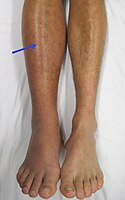
Photo from wikipedia
To achieve the most desirable post-operative results, operation techniques and procedures for total knee arthroplasty (TKA) are highly standardized. However, debates persist whether patients having undergone a gap balancing technique… Click to show full abstract
To achieve the most desirable post-operative results, operation techniques and procedures for total knee arthroplasty (TKA) are highly standardized. However, debates persist whether patients having undergone a gap balancing technique (GB) perform better than those having undergone measured resection (MR) technique. Therefore, a meta-analysis study was conducted to investigate advantages of GB compared to the MR. The focus of the present study was on clinical and functional scores, radiological measurements and further complications. The present meta-analysis was conducted according to the PRISMA checklist. In November 2019, literature search was performed. All clinical studies comparing measured resection technique versus gap balancing technique for primary total knee arthroplasty were considered for inclusion. Only articles reporting quantitative data under the outcomes of interest were eligible for inclusion. The methodological quality assessment and statistical analyses were performed through the Review Manager Software version 5.3 (The Cochrane Collaboration, Copenhagen). Data from 25 clinical trials (2971 procedures) were collected. Patient baseline demonstrated a good comparability. No difference among the two cohorts was found in terms of SF-12 Mental and Physical, ROM, KSS, KSS Function, OKS, WOMAC. No difference was found in the alignment of mechanical axis and femoral rotation. During the knee motion, no difference was found between the medial and lateral gaps among the two techniques. The GB showed a significant elevated joint line (P < 0.0001), along with a longer duration of the operating time (P = 0.001). No differences were found in terms of revision surgery, aseptic loosening or prosthetic infections. GB and MR achieve similar outcomes for TKA. In the GB group, a proximalisation of the joint line and extended operating time was detected. Regarding the additional outcomes of interest, the present analysis showed comparability between both groups, MR and GB.
Journal Title: Archives of Orthopaedic and Trauma Surgery
Year Published: 2020
Link to full text (if available)
Share on Social Media: Sign Up to like & get
recommendations!